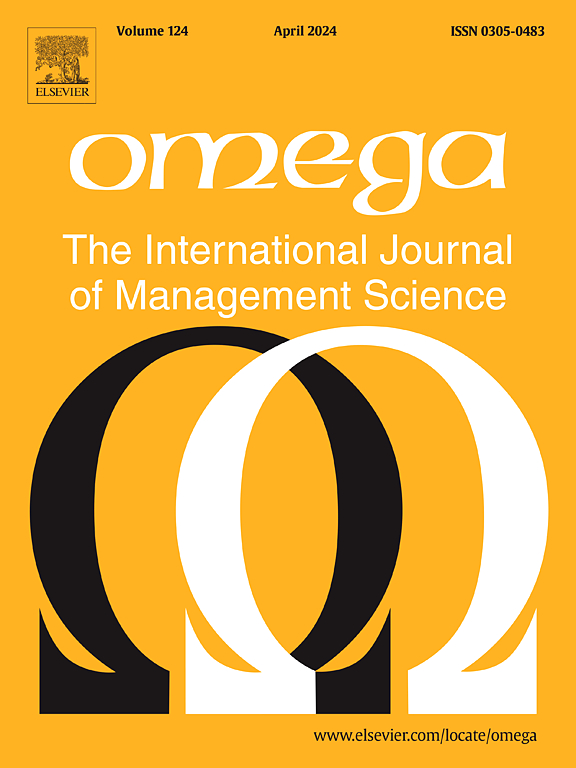Planning container flows through the Eurasian rail network: Managing ad-hoc demand under limited capacity
IF 7.2
2区 管理学
Q1 MANAGEMENT
Omega-international Journal of Management Science
Pub Date : 2025-07-19
DOI:10.1016/j.omega.2025.103395
引用次数: 0
Abstract
In the post-COVID era, supply chain viability (SCV) has gained significant attention, requiring supply chains to be both resilient and adaptable to unforeseen disruptions. The Eurasian rail freight presents a viable alternative to complement traditional maritime shipping routes in times of disruption. A surge in ad hoc demand for Eurasian rail freight presents challenges to the network’s limited capacity and complex coordination across railway systems, exceeding the limits of current manual planning. Furthermore, converting the Eurasian rail freight system from a subsidy-driven model to a revenue-funded transport system is urgent. While revenue management plays a crucial role in optimizing transport networks, this area has received significantly less attention in the intercontinental rail freight industry compared to the airline sector. This paper develops the Revenue Management-Intercontinental Scheduled Service Network Design (RM-ISSND) model, a decision support system that aims to optimize revenue in intercontinental rail freight transport for ad hoc demands. The model supports intercontinental rail freight planning by identifying the most profitable ad hoc shipments while rejecting those that do not contribute to maximizing total revenue and are better suited for maritime or air transport. The RM-ISSND model also facilitates a shift from block routing (all containers in an order follow the same path), which is commonly used in Eurasian rail freight, to a new operational principle with free routing (containers in an order are free to be routed along different paths), enhancing both efficiency and profitability. Experiments show that prioritizing transit times between 27 and 35 days in the existing Eurasian rail freight network yields higher profits, underscoring the need to improve border crossing and main transit times to attract more time-sensitive ad hoc orders.
规划欧亚铁路网的集装箱流动:在有限的运力下管理特别的需求
在后新冠时代,供应链可行性(SCV)受到了极大的关注,这要求供应链既具有弹性,又能适应不可预见的中断。欧亚铁路货运提供了一个可行的替代方案,以补充传统的海上运输路线在混乱时期。欧亚铁路货运的特别需求激增,对铁路网络有限的容量和跨铁路系统的复杂协调提出了挑战,超出了目前人工规划的极限。此外,将欧亚铁路货运系统从补贴驱动模式转变为收入资助的运输系统迫在眉睫。虽然收入管理在优化运输网络方面发挥着至关重要的作用,但与航空部门相比,这一领域在洲际铁路货运行业受到的关注要少得多。本文建立了收益管理-洲际定期服务网络设计(RM-ISSND)模型,该模型是一个决策支持系统,旨在优化洲际铁路货运的临时需求收益。该模型通过确定最有利可图的临时运输来支持洲际铁路货运规划,同时拒绝那些对总收入最大化没有贡献、更适合海运或空运的运输。RM-ISSND模型还促进了从欧亚铁路货运中常用的块路由(订单中的所有集装箱都遵循相同的路径)到自由路由的新操作原则的转变(订单中的集装箱可以沿着不同的路径自由路由),从而提高了效率和盈利能力。实验表明,在现有的欧亚铁路货运网络中,将运输时间优先安排在27至35天之间会产生更高的利润,这强调了改善过境和主要运输时间的必要性,以吸引更多对时间敏感的临时订单。
本文章由计算机程序翻译,如有差异,请以英文原文为准。
求助全文
约1分钟内获得全文
求助全文
来源期刊

Omega-international Journal of Management Science
管理科学-运筹学与管理科学
CiteScore
13.80
自引率
11.60%
发文量
130
审稿时长
56 days
期刊介绍:
Omega reports on developments in management, including the latest research results and applications. Original contributions and review articles describe the state of the art in specific fields or functions of management, while there are shorter critical assessments of particular management techniques. Other features of the journal are the "Memoranda" section for short communications and "Feedback", a correspondence column. Omega is both stimulating reading and an important source for practising managers, specialists in management services, operational research workers and management scientists, management consultants, academics, students and research personnel throughout the world. The material published is of high quality and relevance, written in a manner which makes it accessible to all of this wide-ranging readership. Preference will be given to papers with implications to the practice of management. Submissions of purely theoretical papers are discouraged. The review of material for publication in the journal reflects this aim.
 求助内容:
求助内容: 应助结果提醒方式:
应助结果提醒方式:


